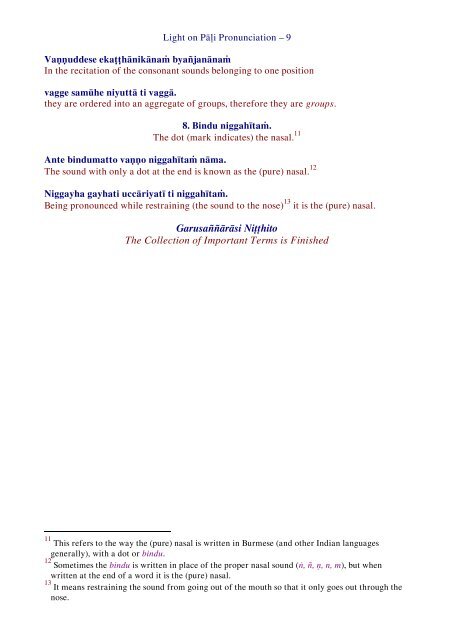Light on Pāḷi Pronunciation
A translation of the opening section of the Niruttidīpanī by Ledi Sayadaw, which is an alternative explanation of the aphorisms of the grammar by Ven Moggallāna.
A translation of the opening section of the Niruttidīpanī by Ledi Sayadaw, which is an alternative explanation of the aphorisms of the grammar by Ven Moggallāna.
Create successful ePaper yourself
Turn your PDF publications into a flip-book with our unique Google optimized e-Paper software.
<str<strong>on</strong>g>Light</str<strong>on</strong>g> <strong>on</strong> <strong>Pāḷi</strong> Pr<strong>on</strong>unciati<strong>on</strong> – 9<br />
Vaṇṇuddese ekaṭṭhānikānaṁ byañjanānaṁ<br />
In the recitati<strong>on</strong> of the c<strong>on</strong>s<strong>on</strong>ant sounds bel<strong>on</strong>ging to <strong>on</strong>e positi<strong>on</strong><br />
vagge samūhe niyuttā ti vaggā.<br />
they are ordered into an aggregate of groups, therefore they are groups.<br />
8. Bindu niggahītaṁ.<br />
The dot (mark indicates) the nasal. 11<br />
Ante bindumatto vaṇṇo niggahītaṁ nāma.<br />
The sound with <strong>on</strong>ly a dot at the end is known as the (pure) nasal. 12<br />
Niggayha gayhati uccāriyatī ti niggahītaṁ.<br />
Being pr<strong>on</strong>ounced while restraining (the sound to the nose) 13 it is the (pure) nasal.<br />
Garusaññārāsi Niṭṭhito<br />
The Collecti<strong>on</strong> of Important Terms is Finished<br />
11 This refers to the way the (pure) nasal is written in Burmese (and other Indian languages<br />
generally), with a dot or bindu.<br />
12 Sometimes the bindu is written in place of the proper nasal sound (ṅ, ñ, ṇ, n, m), but when<br />
written at the end of a word it is the (pure) nasal.<br />
13 It means restraining the sound from going out of the mouth so that it <strong>on</strong>ly goes out through the<br />
nose.


















